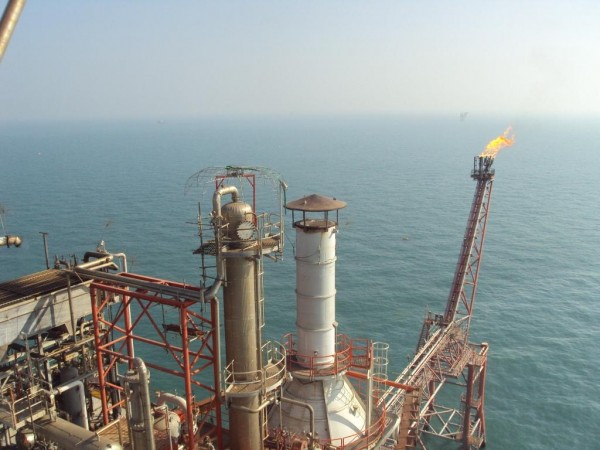- We Prevent Lightning Related Problems.

Lightning Protection: Operations Down! Power Off!
October 9, 2014
Lightning Protection: Towers Everywhere!
November 3, 2014Lightning Protection: Offshore Ain’t Immune!

Lightning Protection Blog
Week 99 | October 16, 2014
Offshore facilities and Rigs have thought that since they are located in the water that they are somehow immune to lightning strikes. Think again!
Offshore rigs and platforms are thought of as “grounded” to the ocean. However, the environment, and even the design of the facility itself, may lead to a compromise in bonding with rust and oil deposits that impede the energy’s path to ground. This leaves the advanced electrical and electronic systems and personnel susceptible to severe damage from not only direct strikes but dangerous secondary surge effects of lighting as well.We can Prevent this by using Lightning Protection System.
When it comes to threatening the offshore community, thermodynamic processes typically start near shore and can evolve into open water events. As a result of continuing changes to our climate lightning events are becoming more frequent, severe and stronger. Offshore facilities are becoming increasingly prone to lightning strikes.
Many upstream companies such as Transocean, Chevron, Texaco, ExxonMobil and BP are trying to tackle the issue of how to stay online and not compromise productivity – or safety – during increased instances of bad weather and are beginning to implement comprehensive lightning protection systems in line with risk mitigation best practices.
Lightning Protection – Offshore Best Practices
- Assess vulnerability to determine proper solutions
- Improve level of safety for the workforce
- Protect vessels against direct strikes and secondary surges
- Reduce downtime and associated costs
- Extend facility life through preventative measures
During 2012, solutions for nearly a dozen companies’ offshore platforms and rigs were produced in the waters off the coasts of Africa, the Middle East and parts of Europe, Asia and Latin America, following vulnerability studies based on IEC and NFPA guidelines and standards. Many included DAS to halt current — and prevent future — costly effects of a lightning strike. Charge Transfer Systems such as The Dissipation Array System (DAS) prevent lightning strikes in an “area of protection” by discouraging the attachment process of lightning, rather than attracting it to the area like older lightning rod systems that collect the strike were designed to do. LEC’s market-leading experience and knowledge has guided the evolution of the system, which retains a 99.87% reliability rate, leading the company to provide a unique “no-strike” guarantee.

BG Group Platform off the cost of India with Spline Ball Inonizers and DAS protection
It’s not just about direct strikes. Protecting sophisticated equipment – and significant investments – from secondary surges that wreak havoc on electrical instrumentation and equipment after the event is becoming a bigger topic in the energy production industry. With every upgrade in technology, sensitive systems like dynamic positioning (DP), drilling instrumentation and control and other rig management systems essential to staying online are becoming more vulnerable.
Determining the mean-time-between-failure (MTBF) for sensitive systems is a challenging task, much more difficult than simply calculating the raw dollars lost through obvious damage and downtime. As systems become smarter and more efficient, they are also more intricate and vulnerable. The voltage needed to run the instrumentation controls decreases and the risk of a high-energy secondary surge damaging equipment and affecting the operations on a rig or platform rises. In the end, it could cost $20,000 to $60,000 per hour or more when a system is down. And that does not include the replacement costs of the equipment affected.
Protecting a vessel from lightning strikes also protects the systems that would otherwise have lost a considerable part of their lifespans. With the uncertainty of the world economy, many companies look to more preventative measures for their cost-effective protection, like Charge Transfer Technology (CTS) as a way to extend the lives of older vessels and become more risk averse with new construction.
Lightning Protection Solutions Overview – Offshore Platforms and Rigs
Not every case is the same, so it is important to start with a *risk assessment to determine the level of vulnerability the rig or platform faces based on IEC and NFPA guidelines and standards. An engineer interviews key rig/platform technical personnel, review schematics and wiring diagrams for crucial components and inspect in situ grounding practices.
A detailed site survey should be provided giving sound reasoning for the proposal offered, as each one is tailored to the needs of the rig or platform in question. Some rigs may only need surge protection devices (SPD), which have become critical to protecting power distribution and low voltage instrumentation and control. Other rigs and platforms may need a no-strike system to provide security against lightning strikes on the helipad, drill derrick or jack-up legs.
Lightning Protection Systems, Surge and Services for Offshore Facilities
Offshore Facilities should consider using products that prevent an incident from occurring first and enlisting lightning protection companies who provide engineering services when wanting to protect effectively against a direct strike and the secondary effects of lightning.
Lightning Eliminators & Consultants, Inc. (LEC) has the only patented lightning prevention solution on the market today and will only allow engineers to work with its customers to provide the services and products required to design a complete lightning protection solution. View LEC’s Offshore Rigs and Platforms Case Study for information on complete protection.
- Consulting Services- Risk Assessment, Site Survey, Design
- Lightning Protection Systems
- Dissipation Array System (DAS)
- Spline Ball Ionizer (SBI)
- Spline Ball Terminal (SBT)
- Surge Protection Devices
- Facility Guard (FG200 & FG400) – Panel Mounted Surge Protection capacity up to 400,000 amps per phase.
- Power DIN PD-65 – Transient Voltage Surge Suppression Device for DIN Rail Applications
- DLP DIN 8 – Hybrid Surge Protector in a Low Cost, Compact, 8 circuit enclosure.
- Data Line Protector (DLP) – for ALL types of data lines, instrument lines, phone lines, current loops, and DC circuits.
If you have any lightning stories you would like to share with us, positive or negative and/or if you have any questions or need additional information please feel free to contact me at LightningDiva@lecglobal.com
Be careful out there! Visit www.lightningprotection.com for all your lightning protection needs. Follow us on Twitter, Facebook and LinkedIn for more information and updates as well as some great photos. Thank you for visiting!

